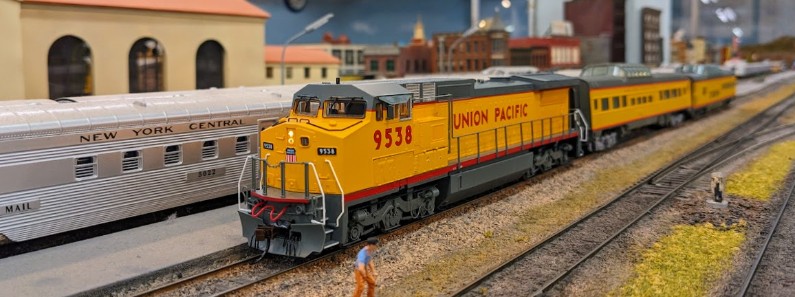The Randall Museum in San Francisco hosts a large HO-scale model model railroad. Created by the Golden Gate Model Railroad Club starting in 1961, the layout was donated to the Museum in 2015. Since then I have started automatizing trains running on the layout. I am also the model railroad maintainer. This blog describes various updates on the Randall project and I maintain a separate blog for all my electronics not directly related to Randall.
2025-03-09 - UP 9538 on automated Mainline Passenger Train
Category RandallRecently the Mainline automation was back at using the good old Athearn UP 8736 engine. After the fiasco of the Walthers units, I’ve decided to try something different, so here we have the Mainline automation train pulled by this new Bachmann UP 9538:
Whilst I was at it, I’ve changed the Mainline Freight train to use SD70ACe 1072 instead of 1067. These are two Bachmann engines that have proven quite resilient and successful over the years. I recently cleaned 1072 and it’s running fine after a good cleanup of the wheel power pickup.
UP 9538 is a GE Dash 8-40CW, replacing the EMD SD70ACe. I chose these engines because they are both modern and highly recognizable.
UP 9538 is currently an experiment. I want to give them a few weeks to evaluate how well it behaves in automation. The engine uses a more modern TCS Wow Diesel, with a fairly capable “current keeper” capacitor as can be seen in this loco chassis image.
I personally do not like TCS decoders due to their Dual Function, Pagination modes, and Audio Assist which, ironically, makes them unnecessarily more complex instead of simplifying their usage -- that thing basically maps 3 different functions all on the same F8 function key, and IMHO is extremely confusing to use because it means function buttons can suddenly do different things if I mistakenly press F8 by mistake.
However when reading the TCS decoder manual, I was glad to find out that CV 242 can be used to disable the Audio Assist feature, CV 117 can be used to disable the Pagination mode feature, and CVs 238 and 241 can be used to disable the unnecessary Dual Functions. I tried that on the programming track, and it made the DCC decoder much more predictable to use, and it works adequately with my automation program.
At some point when trying out the engine, I totally lost the prime mover sound -- I had the horn / bell sound but no prime mover at all. After looking at the manual above again, I finally found that I likely pressed “F6 startup sound” by mistake (or maybe I did not press it and changing the NCE remotes applied the controller’s current function state, which has F6 off). Unlike what the name implies, that F6 controls not just the starting sound but the whole prime mover sound.
The one thing I do miss from other decoders is the “engine moves only after the end of the startup sound sequence” functionality. In the LokSound v4 or v5 settings, that’s called “Prime Mover Starting Delay” (oddly named “Delay Starting if Drive Sound Enabled” in JMRI). In a Soundtraxx Tsunami 2 (pdf), that’s called “Engine Interlock” (a.k.a. “Engine RPM Interlock” in JMRI). That feature has its pros and cons. Lacking that feature, it can be simulated in Conductor 2 using a small 5-10 seconds delay after the sound is enabled, albeit we don’t know if that’s a startup sound or a regular mute/unmute operation
The TCS Wow Diesel seems to make a decent job at reproducing the angry bubbling noise of the Dash 8-40CW prime mover. I’m honestly not too keen on the sound of these GE 7FDL16 engines; I think the EMD 710 prime movers sound much better, not to mention their cool air startup sound sequence!

